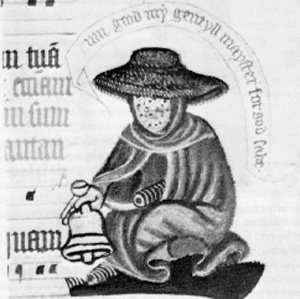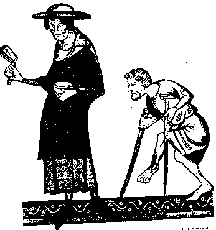
Definition:
The official disease, leprosy, produced by Mycobacterium leprae, was not scientifically identified until 1874, and the cause for the disease was not proven until the 1960s. It is difficult to diagnose even today; therefore, there must have been much confusion surrounding the disease in the Middle Ages. Those classified with leprosy, especially during the Middle Ages, did not necessarily exhibit any of the common symptoms. The classification "leper" was given to many social deviants. Consequently, for purposes of studying lepers in the Middle Ages, we will define lepers as R.I. Moore does in Formation of a Persecuting Society, as "those who were called lepers and treated as such.".
The general characteristics of the disease include, but are not limited to:
--loss of sensation at the nerve ends--destroyed blood vessels, ligaments and skin tissues
--eroded bones
--sores
--ulcers
--scabs
 |
Note the portrayal of the leper with a clapper and a begging bowl. |
The issue of a person's wealth was important when they became known as a leper. Rich lepers were treated very differently than poor ones. The stories of Alice the Leper and Baldwin IV (see Annotated Bibliography) show that if people were leprous but rich, they were depicted as heroes. Alice was shown as a martyr, and Baldwin still ruled his kingdom in his leprous state. It was not their fault that they were lepers, whereas it was thought that most people contracted leprosy as a punishment from God for their sins. Lepers that were poor had to carry begging bowls, as seen in the pictures above and to the right. Societies considered them burdens because they could not work. The poor leper seems to have been relegated to the the margins.
The Sin of the Leper:
As "leprosy" grew more prevalent during the Middle Ages, the status of lepers changed. Far from being pitied, lepers became increasingly more reviled by the populace. The vocabulary linking sin with leprosy increased in frequency. This idea may have been most aided by the expanding power of the church. The church rhetoric of equating uncleanliness with sin was used by all levels of the population. This association led to the equivalence between lepers, sin and punishment.
Rhetoric Common With Other Groups:
- Lepers were made to wear distinctive clothing. (See the Mass of Separation.) Jews and prostitutes also had to wear marked clothing.
- Leprous people were forced to live outside the city or in a separated area. The same was true of prostitutes and Jews.
- They were considered unclean and sinful. The same vocabulary was used to describe homosexual couples, Jews, and witches.
- Lepers were often accused of sexual deviancy.Some leper houses even required that lepers take vows of chastity.
Links:
 |
Documents
Bible Verses.Testament of St. Francis.
El Cid See Book IX for the story of St. Lazarus, the patron saint of lepers.
Excerpts from Alice the Leper, a nun who became a leprous martyr.
Essays
A Medieval Diagnostic of LeprosyEssay about Medieval Jewish Perspectives on Lepers
Images
Painting of St. Louis with Leprous Monk--A Link to the Bibliotheque Nationale.Painting of A Miracle of St. Nicholas. An image, from the National Gallery of Art, of lepers visiting the shrine of St. Nicholas in an attempt to cure their leprosy.
Other Links
Basic facts regarding leprosy.More facts about lepers.
History of lepers.
An abstract of a dissertation on leper hospitals.
More on St. Francis.
For additional sources not on the Internet, see Annotated Bibliography.
An extended non-annotated Bibliography.
--This page designed and written by Jessica Edwards, Lindsay Irvin, and Kara McClurken